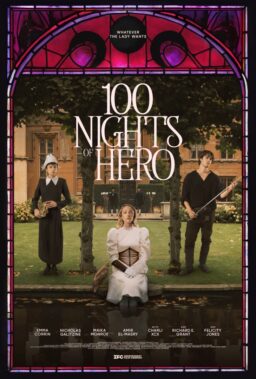At last year’s San Diego Comic-Con, Nell Minow and I separately got to experience the Oculus Rift. This year, I leapt into the future of movies with three different 360-degree experiences.
Major movies have already gone 3D but smaller movies are taking us to a virtual world in which we walk and make choices in a 360-degree reality. Outside of the actual SDCC, was a free-to-the-public experience in the FX Fearless Arena. The Fearless Arena was a bigger, more ambitious undertaking than last year’s “The Simpsons” themed activities. Think of it as a high concept haunted house well ahead of Halloween, featuring advertising opportunities for new and old FX series: “American Horror Story,” “Fargo,” “The Strain” and “The Bastard Executioner.”
In “The Strain” building, groups of 10 were led in, seated and given goggles and noise-canceling earphones. When the program started, we first saw the red title “The Strain” and were led into a dark and slightly out-of-focus world of life and death as we were being chased by the infected vampires through a dingy old factory or warehouse. You had a choice of where you looked and unlike the Oculus Rift, I didn’t see any glitches or rough patches of broken continuity in the images.
Inside the convention center, in the exhibition hall at booth 2543, Roddenberry Entertainment had an ominous 360-degree movie experience called “White Room: 02B3.” Six strangers (Breckin Meyer, Tamlyn Tomita, David Blue and Rachel True, as well as Internet icons Tony Janning and Milynn Sarley) find themselves in a stark, futuristic white room as part of an experiment. The tone is somber and sometimes desperate as the six discuss their situation. Instead of having special goggles or head gear, this movie requires the download of an app on your mobile device. By moving your mobile device, you can choose to see different people as you are all seated at a great round white table.
Google’s Advanced Technology and Projects group had a panel about its 360-degree project, “An Inside Look at Google Spotlight Stories.” Google Spotlight Stories were first launched in October 2013 and feature animated stories. The first four stories are already available on Android only via the Google Play store: “Windy Day” (directed by Jan Pinkava), “Buggy Night (directed by Mark Oftedal), “duet” (directed by Glen Keane) and “HELP” (directed by Justin Lin).
“Windy Day” is about a rust-colored hat, a grey forest-dwelling mouse and a windy day. “Buggy Night” is about a bug, some light and a dark night. I was more familiar with “duet,” a dialogue-free animated feature that takes a boy from babyhood to adulthood. The boy’s first companion is his dog, but from time to time, he sees the girl who strives to be a dancer. Lin’s “HELP” is a live-action, 5-minute short film that took two years to make and is about an alien attack on Los Angeles. Lin’s mobile device movie was released this year in May.
Four more Spotlight Stories are scheduled to launch this year: Emmy Award-winning artist Shannon Tindle’s story about an ice skating show gone wrong, “On Ice”; Tim Ruffle directs a holiday-season themed piece called “Special Delivery”; Oscar-winning director Patrick Osborne is working on a film told in a musical format called “Pearl”; and the London-based studio Nexus Productions is working on a story about a girl who is followed by rainy days in “Rain or Shine.”
During the panel discussion, the clip shown to the audience hinted that even traditional 2D animators have to think in 3D. Because the viewer has a choice of where to look, the set design becomes more like a theater mock-up of a stage—not unlike what stop-motion animators must do to plan. While stage productions have a concept of theater in the round—the stage is surrounded by the audience and thus the director must plan for groupings that allow the action to be seen from all sides—this is more theater “in the surround.” The action occurs around the viewer or audience member. Instead of the viewer being off to one side or on the periphery of the action, the viewer in the center.
There are other problems. Scot Stafford, the composer for the Google Spotlight stories, noted that scoring for a movie that has alternative flow depending upon where the viewer chooses to look means that the score must be cohesive to match different viewer experiences and yet not be repetitive but contribute to the emotional, intimate experience.
The directors also noted that the movies tend to be more intimate, are meant to be viewed on a small screen and create a world that the viewer inhabits alone.
As the Google Spotlight movies are available only for Android mobile devices, people who own Apple products will have to wait to get the full experience or become an Android/iOS family.












